1st Polish People's Army
Pierwsza Armia Wojska Polskiego
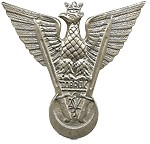
On his release from the Lubianka in 1941, General Anders was set up in a Moscow apartment with Colonel Zygmunt Berling and Lieutenant-Colonel Dudzinski. Through their discussions of their experiences of Soviet imprisonment, they had identified there were three main Polish prisoner camps at Starobielsk, Kozielsk and Ostashkov that housed 11,000 POWs. Starobielsk and Kozielsk housed officers and all the camps were abolished in 1940. Concerns mounted when it was evident that no one knew the whereabouts of the inmates other than some 300 officers had been detained at the Pavlischev-Bor camp before being moved to Griasovietsk.
Anders recalled in his memoirs published in 1949 that Berling and Dudzinski were keen to co-operate with the Soviets and remained vague as to their own experiences, which raised suspicion. Berling had served in 1st Brigade of Pilsudski's Legions and his enthusiasm for the Soviets was at odds with his earlier pre-war military career. On the arrival of a Polish Military Mission to Moscow, led by Major-General Bohusz-Szyszko Anders discover the deceit over the numbers of Polish POW's missing. Major-General Bohusz-Szyszko had indicated that a Polish-Soviet Agreement was under negotiation that would enable a Polish Army to be created inside Soviet Russia.
On 14th August 1941 the Polish-Soviet Military Agreement was signed and the headquarters would be based at Buzuluk. Anders was tasked to set up two divisions where the 5th Division would be based in Tatistchev and the 6th Division together with a reserve regiment would be based in Totskoie. By September 1941 the camps were being emptied out and the truth dawned. The NKVD indicated 475,00 Poles had been deported between 1939 -1941. However Anders research indicated 1.5m to 1.6m, which included Jews, White Russians and Ukrainians from former Polish territory had been deported and confirmed by the government in exile. The massacre of Polish officers at Katyn was not discovered until 1943 by the Germans. Those who joined Anders army were in very poor health and dressed in tattered uniforms due to the conditions in the labour camps or gulags. By December 1941 the suspicion over missing officers became deeper and Sikorski's meetings with Stalin over Polish-Soviet Military Agreement and recognition of Poland's former boundaries became more divided and entrenched. 'Uncle Joe' already had mapped out his future for eastern and central Europe.
By March 1942 plans to move to Persia were well advanced and civilians had heard the rumour and had started to flood south towards the Polish military camps in the hope they too could escape. Anders decided not to follow the orders from Ambassador Kot to leave families behind as they would never leave Russia alive and be left to starve. By August 1942 most units had left Russia, but 115,000 Poles had to be left behind.
Berling had decided in August 1941 to enrol in the Red Army (Anders, 1949), but had been transferred with the Polish 5th Division to Djalal-Abad in Kyrgyzstan in 1942 where he had been appointed chief of staff to the division. However, a personality clash with General Boruta resulted in seven days house arrest, demotion and transfer to Krasnovodsk from where he deserted in August 1942.
Anders received reports that Berling and several officers had received their induction into the Red Army. The re-education of Berling and his meteoric rise within the Soviet backed army laid the foundations of communist control in post-war Poland (Walker, 2008). In reality few Polish officers who had been in the Gulags embraced the Soviet system. Berling and some fellow officers languished in relative comfort while absorbing the minutiae of the Soviet system while housed in a villa called the "Villa of Happiness" near Moscow. Not long afterwards the Union of Polish Patriots was inaugurated (Anders, 1949, Bor-Komorowski, 1951) and Berling was sentenced to death for treason in absentia by military tribunal called for by Anders.
In 1943 Russia broke off diplomatic ties with the Polish Government in Exile based in London. Soon afterwards the Soviets pledged their support to the Union of Polish Patriots and the planning of a communist state in Poland (later referred to as The Lublin Committee). On 13th May 1943 the Soviet support was announced in the Wolna Polska and the Polish Kosciuszko Division was formed from the remnants of deportees left behind by Anders. The army was formed in the Zhytomiezh and Berditschev in the Ukraine.
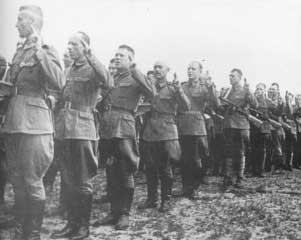
|
|
28-30th July 1943 soldiers of the 1st Tadeusz Kosciuszko Division at Selítse
|
In the winter of 1943 -1944 as the Soviet Red Army pushed the German forces west and liberated areas such as Vohlynia. From April 1944 the main training depot was based at Sumy, which received former Polish deportees from all over Russia and 'volunteers' or conscripts from liberated areas (Bor-Komorowski, 1951) who numbered approximately 78,000. Here new units were formed: 4th Infantry Division and the 1st Cavalry Brigade supported by four artillery brigades, an anti-aircraft division and the 1st Sapper and Engineering Brigade. Sumy was also the training centre for partisan liaison personnel. Additional combat training was carried out at Sel'tse in the Ukraine.
A Military School was set up at Riazan to train officers. There was a need to fill 'the inexplicable gap' in officer numbers that was subsequently explained by the Katyn Massacre (where the NKVD had shot 4,000 Polish officers in 1940). Polish soldiers dedicated to the communist cause needed to be trained as officers as the 1st People's Army had also depleted the Red Army's capacity of capable officers.
1st People's Army was seconded to the Red Army to form part of the 1st Byelorussian Front under the command of General Konstantin Rokossovski and remained in the rear at Kivertse as a reserve unit while training was completed. On 18th July 1944 the Byelorussian Front started an assault that after three days broke the defensive lines near Kovno. By 20th July 1944 the 1st People's Army marched towards Poland and crossed the River Bug in support of the 69th Army and attacked along the Radzanów - Lubartów - Michów line. The Polish army passed through and liberated Chehm, Lubelski and Lublin to a mixed reception. The AK had been ordered to assist the advancing Red Army. They were often in support roles as 'pathfinder' units and as the Red Army crossed Poland contingents of AK were either forcibly enrolled into the Red Army or shot.
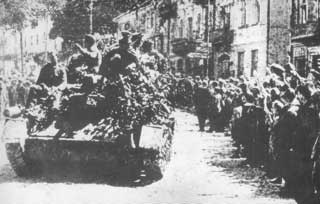
|
|
Chehm - Lubelski liberated on 23rd July 1944
|
On entering Lublin the Russians set up the Polish Committee for National Liberation (PKWN) with a decree all Polish forces should unite (Anders, 1949). Churchill and Eden had been too slow to provide effective support for the Polish government in exile and finally sought Roosevelt's support albeit too late. Miko?ajczk, Romer and Grabski were sent to Moscow to negotiate from an already weakened position with Stalin and Molotov conceding nothing. Mikolajczk's plan for an independent Polish republic lay in tatters (Tebinka, 2001). Politically the government in exile were neutered and the power base of the Lublin Committee was demonstrated when the commanders and staff of the AK in the Vilno and Novogrodek region were arrested, the 27th Infantry Division disarmed and fresh deportations to Siberia and the Semipalatinsk district began and many did not return.
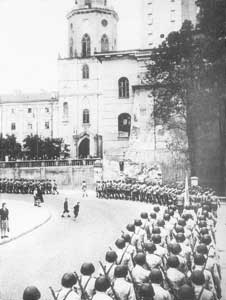
|
|
Lublin
|
Red Army successes meant the front stretched from Brest - Lublin and in sight of the river Vistula. From 28th July until 8th August 1944 the Polish People's Army was sandwiched between the Red Army's 8th and 69th Armies along a 25km stretch of the Vistula between Rycice and Wlostowice. Although the river Vistula had been crossed at Wólka Profecka, a German counter-attack halted any further crossings. The 1st Polish Army switched its focus on the bridgehead at Warka-Magnuszew and came under heavy defensive fire from the German lines, which enabled the Russian 8th Guards Army to capture the Magnuszew bridgehead. After the 8th September more units crossed the Vistula and took up position with the 1st Westerplatte Heroes Armoured Brigade in close support. The 2nd and 3rd Infantry Divisions were assigned the defence of the right bank of the Pilica River. The ground holding operation was designed to engage the German Army and to hold them within this sector of the front rather than aim for strategically more important goals. In the rear positions 'mass mobilizations' and clear up operations by the NKVD took place.
The AK had initiated operation Burza in key areas of Poland in order to save historic cities and civilians caught up in the general uprising (Bor-Komorowski, 1951). The AK had some 380,000 soldiers of which 40,000 were in Warsaw (Anders, 1949). The outbreak of the Warsaw Uprising stalled the 1st Byelorussian Front not far from Otwock. The circumstances surrounding Stalin's decision still remains contested and the lack of plausibility angers Poles to this day. Stalin maintained the German forces concentrated around the city especially on the Vistula and Narev rivers meant higher casualties and collateral damage to the historic city. Politically Stalin put it down to "the Soviet authorities decided to keep away from the 'Warsaw adventure' as they should not and must not take any responsibilities". The 'fracas' was seen by the Soviets as hampering their military operations while the Luftwaffe had freedom of the skies over Warsaw to bomb unheeded (Kondracki, 2001).
Berling's Polish Peoples Army had been moved to the bridgehead at Warka-Magnuszew to 'sit out' the start of the Warsaw Uprising. For days the citizens of the fine city fought knowing help was at close hands. As the Uprising began to collapse after 63 days of fighting and the Germans were hell-bent on raising the city to the ground, the 1st Byelorussian Front resumed its attack with the 70th and 47th Armies crushing the German army on the right bank of the Vistula and attacking south through the towns of Miedzeszyn, Anin, Wawer, Kaweczyn and towards the quarter of Praga. (Today houses in this quarter have the AK and Uprising symbols painted on the walls as a reminder).
Engineers built pontoons and adapted river barges to assist in the river crossing from the main bridgehead. The Germans attempted to block the build-up of forces at the bridgehead by engaging the famous Herman Göring Panzer Division, however the Polish 1st Armoured Brigade and the Soviet 8th Guards Army repulsed numerous attacks which resulted in the destruction of 40 German armoured vehicles around Studzianki.
The 1st Polish Infantry Division were assigned to the 76th and 175th Soviet Infantry Divisions and broke through the defensive lines at Miedzylesie and pushed on to the edge of the road running from Czaplowizna-Wawer. On 12th September the polish Division had seized Kaweczyn and were on the outskirts of Praia by the evening. At dawn of 13th September the 1st Polish Infantry Division fought through the streets almost house to house towards Wschodni and overcame numerous counter-attacks until the railway station at Wilenski was captured. At the same time the 175th Soviet Infantry Division captured Grochów while the 76th Soviet Infantry Division captured Targówek. The 70th Army was repulsed and the front line still held at Praga.
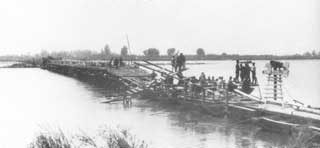
|
The 1st Polish Infantry Division was stood down and was again back in action from 16th September. The Division was placed along the Vistula with 2nd Infantry Division taking up positions in Zoliborz towards the bridge at Poniatowski whose positions were held by the 1st Cavalry Brigade. The 3rd Infantry Division had been moved into the residential districts of Las and the nearby area of Czerniaków. These actions took place as the brave fighters of the 'Uprising' were beginning to crumble and had been primarily constrained to the districts of Sródmiescie. At the last moment orders were given for the bridgeheads to be attacked to relieve the freedom fighters within the city. The 1st Polish Infantry Division stormed towards Czerniaków, Zoliborz and Powisle with 420 soldiers from the 1st Battalion and 9th Infantry Regiment with bomber support from the Kraków Squadron. After two days of intense fighting in support of the AK they retreated having suffered heavy losses with all the momentum and initiative to support the AK lost. Fierce opposition by the German army resulted in Berling's decision to evacuate all the bridgeheads on the left bank of the Vistula.
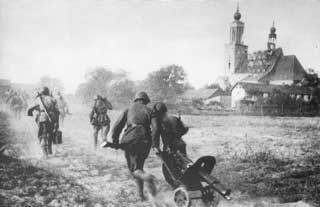
|
|
1st Infantry Division supporting Soviet 76th and 175th Infantry Divisions on southern edge of Praga September 12th 1944
|
On 23rd September the bridgeheads were abandoned leaving the AK to struggle with little hope of re-supply or even tactical support. The Soviets replaced Berling on the pretext that the bridgeheads had been 'insubordination' and carried out independently of the main Soviet battle plans, however, the context of the dismissal remains contested. Berling was initially removed to the Staff Academy at RembertÛw before transfer to Moscow.
With the 1st Polish Army on the right bank of the Vistula and the frontline held on the outskirts of Praga, the army remained ineffective for the battle for the city. For a month Polish and Soviet forces engaged the SS armoured divisions Totenkopf and Wiking. While various units continued to engage the German defences it was not until the army had been strengthened with mortar and the 1st Armoured Tank Brigade did the army have the strength to engage and prepare for the final push for the city. On October 28th 1944 Polish and Soviet army units captured Jablonna and held onto a 44Km front, but it was not until the start of the Soviet 'January Offensive' that the German defences would yield.
The 1st Polish Army command was taken over by Major General Stanislaw Poplawski. Over the winter months recruitment, training and re-structuring saw the creation of the 2nd Polish Army, but plans for a 3rd Army were scrapped. The 1st Byelorussian Front needed to break the German grip on Warsaw. Strategically the city was a defensive stronghold acting as a 'bulge' in the main front, which could not be bypassed in the Soviet drive for other cities in central Poland and the final destination - Berlin.
'Jump-Off' was on 14th January 1945. The Soviet 47th Army was detached from the main battlefront of the 1st Byelorussian Front and moved to attack Blonie. The Soviet 61st Army linked up with the 2nd Armoured Guards Army to assault the line between Warka - Magnuszew bridgehead and link up along the Grójec - Blonie front. The 1st Polish Army had been detailed to operate within the vicinity of Warsaw and would join the main attack on 16th January 1945. The 1st, 3rd and 4th Infantry Divisions backed up by the 1st Armoured Brigade would assault the Praga area from their forward operations area based in Góra Kalwaria while the 1st Cavalry Brigade would join the assault from Otwock. Warsaw was liberated at 15.00 on 17th January 1945. On the following day and under the protection of the 1st Warsaw Fighter Squadron, the 1st and 2nd Infantry Divisions marched through the city centre in a show of ëcommunist solidarityí with the Lublin Committee 'waiting in the wings'. These two divisions remained in the newly liberated city - substantially reduced to rubble by the suppression of the Warsaw Uprising.
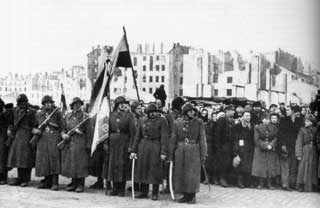
|
|
19th January 1944 1st Polish (Peoples) Army Parade
|
The other units of the 1st Polish Army linked up to the 1st and 2nd Byelorussian Front and began their assault on Bydgoszcz. Rearguard action by the Germans effectively reduced the speed of advance particularly for the Polish 8th Infantry Regiment of the 3rd Romuald Traugutt Infantry Division and the 1st Westerplatte Heroes Armoured Division. For 14 days these units marched and travelled in conditions that were adverse where snowstorms and temperatures of -20c made every kilometre of the 270Km march a battle of endurance. On 30th January the column crossed the former pre-war German - Polish frontier at Sempolno/ Wiecbork.
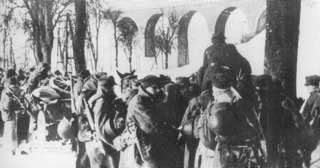
|
|
March to Bydgoszcz
|
On 29th January 1945 the 1st Polish Army started the next phase of the campaign by attacking Wielowicz, Zakrzewo and Jastrowie to the northwest of Bydgoszcz. After two days of fighting Zlotów fell and the Poles began preparations to breach the heavily defended 'Pomeranian Wall' (German: Pommernstellung), which had been built in 1930s as a defensive line to protect eastern provinces of Germany and been enhanced during the war to block the Soviet advances. The main assault took place where the 'wall' met the Gwda River with artillery barrages pounding the heavily fortified network of forts and trenches. On 3rd February Jastrowie and Podgaje fell and the fortifications near lake Dobre were breached despite numerous counter-attacks. On 10th February the attack formation switched direction away from Czaplinek and Drawsko Pomorskie south-east towards Miroslawiec which in effect blocked retreating German units from Walcz and many were liquidated in their flight west.
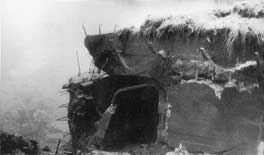
|
|
Breached bunker on the Pomeranian Wall
|
The January offensive resulted in bridgeheads being captured on the Odra River and the German 'Vistula' Army Group being split into two with isolated units left behind in Kurland, Masuria and Pomerania. The Soviet General Zhukov was aware this part of the campaign was to keep pressure on the Germans while the main thrust for Berlin would be further south (Hastings, 2004). On 1st March 1945 the 1st Byelorussian Front moved northwards with the 1st Polish Army attacking the 10th SS Corps breaking through the heavily defended lines at Wierzchowo and Zabno. Linking up with the Soviet 1st Armoured Guards Army, the 10th SS Corps were surrounded and liquidated near the town of Swidno on 4-5th March. The German 'Vistula' Army Group were now trapped in two pockets in the area between Gdansk to Gdynia and between Kolobrzeg to Szczecin. By 7th March the 1st Polish Army was in 'clean-up' operations to liquidate any pockets of German units as they marched towards Slawoborze and Karlino. On 9th March the 16th Infantry Regiment and the 6th Infantry Division had reached the Baltic coast to the west of Kolobrzeg. The sea port of Kolobrzeg was one of the few remaining ports able to evacuate remnants of the German army and settlers. The port had been under siege by the Soviet 1st Armoured Guards Army with the port fiercely defended. On 8th March the Soviet 272nd Infantry Division supported by the Polish 3rd and 6th Infantry Divisions led the assault on the port. As the outer defences were slowly breached, units began to fight in close quarters house to house using flame-throwers to clear houses and cellars. It was a hard fought battle requiring the re-enforcements of the 4th Infantry Division and the 4th Heavy Tank Battalion to hold off counter-attacks and finally clear the port on 18th March with artillery duels against warships protecting the last of the troops carriers from the port. Some 1,300 Polish soldiers were killed or missing and 2,652 injured against German losses of 4,000 killed or wounded and another 4,000 captured.
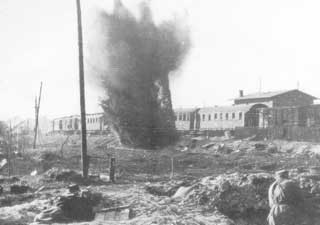
|
|
Kolobrzeg in ruins
|
While the Pomeranian campaign was underway, the 1st Armoured Brigade had been attached to the Soviet 8th Mechanized Corps as part of the 2nd Byelorussian Front in engaging the remnants of the main forces of the German 'Vistula' Army Group in the area of Gdansk to Gdynia. On 12th March the battle group attacked and liberated Wejherowo and then switched their support to the Soviet 321st and 239th Infantry Regiments and again broke German defensive lines near Smiechowo. Casualties were high when they engaged the 4th SS Division near Janów. After a few days withdrawal from the front line, Polish units were back in action for the final push towards Sopot and Gdynia where the Germans regularly counter-attacked with force. Ironically the 'Westerplatte Hereos' took part in the clearing operations along the coast and by 5th April had captured Bialy Bór.
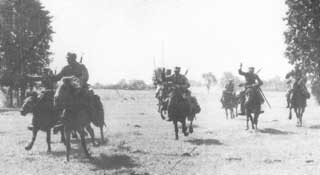
|
|
The last cavalry charge: 1st Cavalry Brigade at the Battle of Borujsko 1st March 1945
|
Regrouped, the 1st and 2nd Polish Armies were to support the Soviet army in the final campaign for Berlin. The 1st Polish Army was sent to the bridgehead at Gozdowice on the River Odra and the 2nd Polish Army was sent to Zgorzelec on the River Nysa. On 14th - 15th Aprl 1945 the 2nd and 3rd Infantry Divisions were relocated and placed at the Soviet bridgehead at Karlsbuse. On 16th April the 1st Infantry Division crossed the Odra at Siekierki after artillery had heavily pounded the German defences in a 'softening up' operation. Also in action was the 6th Infantry Division operating on the right flank. In a flanking operation the Poles met up with Soviet forces in Wriezen forcing a mass German retreat. From 20th to 23rd April the 1st Polish Army pushed towards the Hohenzollern canal, which was defended by SS units who effectively held the line and made the canal crossing hazardous with counter-attacks and breaches in the Polish lines frequent. On 25th April under a heavy artillery barrage Polish units of the 2nd Infantry Division closed gaps in the line and by 27th April units moved further west towards Brandenburg. On 30th April German defences were broken on the Havelländischer Grosser Haupt Kanal and by the 3rd May the 6th Infantry Division had crossed the Havel River towards the Elbe River to link up with the US 9th American Army. Other units had been attached to the main Soviet thrust into Berlin were the 1st Infantry Division, 2nd Howitzer Brigade and the 6th Motorized Pontoon Bridge Battalion alongside the 1st Independent Mortar Brigade. However, on 30th April the 1st Tadeusz Kosciuszko Infantry Division were brought into the street fighting to clear tough pockets of resistance in the Tiergarten and Brandemburg Gate.
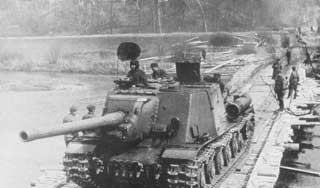
|
|
Crossing at Stara Odra
|
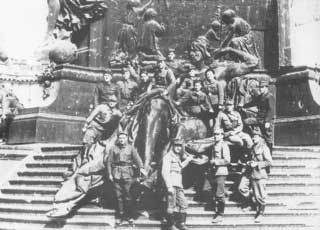
|
|
R'n'R Berlin 1945
|
The 2nd Polish Army was in operations, which moved southwards in a line through Poland with Prague as the goal. On 20th March 1945 the 2nd Polish Army had been transferred under the operational wing of the 1st Bylorussian Front under the overall command of Marshal Zhokov. The 1st Armoured Corps with the 2nd Artillery Division was seconded to the 1st Ukrainian Front under the command of Marshal Koniev and took part in the capture of Wroclaw. The 2nd Polish Army was much larger than the 1st, but was not battle hardened and so its role in the Berlin campaign was significantly different. Their 'jump-off' was scheduled for the 10th April at Rothenburg on the River Nysa. Opposing them was the German Mitte Army Group that also included Panzer units defending the line in front of Dresden. On 18th April the Panzer units counter-attacked and drove a wedge through the 2nd Polish Army, which enable the Germans to re-capture Klitten with part of General Swierczewski's army encircled. Strategically if the Mitte Army Group were able to hold back advances on this sector of the front Marshall Schorner could release Panzer Divisions for the defence of Berlin. However, despite hard fought advances and counter-attacks, the 2nd Polish Army were able to hold a line between Kamenz - Doberschutz - Dauben. The battles were ferocious and at Bautzen casualties were some of the highest of the war. The flank had withheld and after some respite and re-equipped the 2nd Polish Army re-engaged from 6th May onwards in the area of Kamenz-Tauer. Major battles were fought at Bischofswerda and Neustadt with Bautzen recaptured on 9th May. Although Germany was on the brink of collapse, the war raged on and bitter fighting remained. On 10th May Polish units liberated Mielnik some 30Km from Prague and on 11th May Polish tanks had reached the suburbs of Prague.
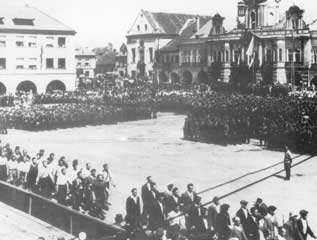
|
|
2nd Polish (Peoples) Army Parade at Mielnik 11th May 1945
|
The Soviet Marshalls' treatment of the 1st and 2nd Polish Army had been ruthless by any standards during its life in WWII. The combatants had either been through the Gulag system or conscripted as areas of Poland were 'liberated'. On the line, these units had been given some of the hardest battles to wage whether it was at Lenino in the Pripet Marshes or the Pomeranian Wall. Many officers spoke no Polish with limited training and skills as officers. In the rank and file, equipment was in short supply and training was rudimentary and rushed always accompanied by the political 'commissar' to ensure loyalty to the new Republic. Not far behind the liberating troops was the NKVD accompanied by advisors and the subsequent 'rape' and 'pillage' of Poland or any other country the Soviet forces passed through (Hastings, 2004, Walker, 2008). The combatants in 1st and 2nd Polish (Peoples) Army meted out a ferocious revenge against the retreating German Army without impunity (Hastings, 2004) as did their brothers-at-arms in the west at battles like the Falaise Gap.
Top of Page
|